Type 2 Diabetes Risk Alleles Demonstrate Extreme Directional Differentiation among Human Populations, Compared to Other Diseases
Many disease-susceptible SNPs exhibit significant disparity in ancestral and derived allele frequencies across worldwide populations. While previous studies have examined population differentiation of alleles at specific SNPs, global ethnic patterns of ensembles of disease risk alleles across human diseases are unexamined. To examine these patterns, we manually curated ethnic disease association data from 5,065 papers on human genetic studies representing 1,495 diseases, recording the precise risk alleles and their measured population frequencies and estimated effect sizes. We systematically compared the population frequencies of cross-ethnic risk alleles for each disease across 1,397 individuals from 11 HapMap populations, 1,064 individuals from 53 HGDP populations, and 49 individuals with whole-genome sequences from 10 populations. Type 2 diabetes (T2D) demonstrated extreme directional differentiation of risk allele frequencies across human populations, compared with null distributions of European-frequency matched control genomic alleles and risk alleles for other diseases. Most T2D risk alleles share a consistent pattern of decreasing frequencies along human migration into East Asia. Furthermore, we show that these patterns contribute to disparities in predicted genetic risk across 1,397 HapMap individuals, T2D genetic risk being consistently higher for individuals in the African populations and lower in the Asian populations, irrespective of the ethnicity considered in the initial discovery of risk alleles. We observed a similar pattern in the distribution of T2D Genetic Risk Scores, which are associated with an increased risk of developing diabetes in the Diabetes Prevention Program cohort, for the same individuals. This disparity may be attributable to the promotion of energy storage and usage appropriate to environments and inconsistent energy intake. Our results indicate that the differential frequencies of T2D risk alleles may contribute to the observed disparity in T2D incidence rates across ethnic populations.
Published in the journal:
Type 2 Diabetes Risk Alleles Demonstrate Extreme Directional Differentiation among Human Populations, Compared to Other Diseases. PLoS Genet 8(4): e32767. doi:10.1371/journal.pgen.1002621
Category:
Research Article
doi:
https://doi.org/10.1371/journal.pgen.1002621
Summary
Many disease-susceptible SNPs exhibit significant disparity in ancestral and derived allele frequencies across worldwide populations. While previous studies have examined population differentiation of alleles at specific SNPs, global ethnic patterns of ensembles of disease risk alleles across human diseases are unexamined. To examine these patterns, we manually curated ethnic disease association data from 5,065 papers on human genetic studies representing 1,495 diseases, recording the precise risk alleles and their measured population frequencies and estimated effect sizes. We systematically compared the population frequencies of cross-ethnic risk alleles for each disease across 1,397 individuals from 11 HapMap populations, 1,064 individuals from 53 HGDP populations, and 49 individuals with whole-genome sequences from 10 populations. Type 2 diabetes (T2D) demonstrated extreme directional differentiation of risk allele frequencies across human populations, compared with null distributions of European-frequency matched control genomic alleles and risk alleles for other diseases. Most T2D risk alleles share a consistent pattern of decreasing frequencies along human migration into East Asia. Furthermore, we show that these patterns contribute to disparities in predicted genetic risk across 1,397 HapMap individuals, T2D genetic risk being consistently higher for individuals in the African populations and lower in the Asian populations, irrespective of the ethnicity considered in the initial discovery of risk alleles. We observed a similar pattern in the distribution of T2D Genetic Risk Scores, which are associated with an increased risk of developing diabetes in the Diabetes Prevention Program cohort, for the same individuals. This disparity may be attributable to the promotion of energy storage and usage appropriate to environments and inconsistent energy intake. Our results indicate that the differential frequencies of T2D risk alleles may contribute to the observed disparity in T2D incidence rates across ethnic populations.
Introduction
The global rise in incidence of type 2 diabetes (T2D) has been called a pandemic, and is now commonly identified as a major international health concern [1]. Although environmental factors play a substantial role in the etiology of T2D, genetic susceptibility has been established as a key component of risk [2], [3]. However, the potential disparities in genetic risks for T2D and other major diseases across different ethnic groups and subpopulations are poorly characterized. In this study, we evaluate the hypothesis that disparities in global patterns of T2D risk allele frequencies contribute to disparities in genetic risk of T2D across diverse global populations, compared with genomic background and other diseases.
We evaluate this hypothesis using three catalogs of genetic variation sampled from diverse ethnic populations [4], [5] and published associations between genetic variants and disease traits [6]. Specifically, we include 1,397 individuals from 11 populations represented in the HapMap project [4] and to follow-up findings, we added 1,064 individuals from 53 indigenous populations across the world in the Human Genome Diversity Panel (HGDP) [7]. Additionally, we recently sequenced and publically released the whole genomes of 49 individuals from 10 diverse populations. Disease associated variants were collated from the thousands of genetic variants associated with increased disease risk through thousands of genome-wide and candidate association studies [8], leveraging our previous efforts to catalog, summarize, and integrate these risk variants across hundreds of human diseases [6].
Enabled by the catalogs described above, a recent analysis demonstrated wide variations in the frequencies of some disease-susceptible risk alleles across 11 HapMap subpopulations [9], but with the caveat that many of the well-known disease SNPs were discovered in population of European ancestry [10]. To further explore the association between individual genetic risks in subpopulations, we propose conducting a systematic evaluation of the differentiation of the risk allele frequencies (RAFs) and individual genetic risks across population groups. The results aim to further elucidate the role of ethnicity in clinical diagnosis of genetic disease risk and also provide guidance towards discovering additional disease-susceptible genetic variants from diverse population groups.
We are focusing on T2D and its comparison with other diseases because of its pandemic prevalence and a striking feature of extreme population differentiation we find in this study. Inconsistent results have been previously reported on the population differentiation of RAF and genetic risk of T2D [11]–[15]. However, to our knowledge, most of the studies have been focused on individual SNPs, and none of them considered the consistency of directions of population differentiation across all T2D-susceptible risk alleles. Furthermore, none of these previous studies have systematically compared the population differentiation between T2D and other diseases.
In this study, we systematically calculate the directional population differentiation of RAFs across cross-ethnic T2D risk alleles using genotyping data from diverse population groups in both HapMap and HGDP, and evaluate the statistical significance of differentiation against genomic background and other diseases. We then calculate the predicted genetic risk (PGR) of 1,397 individuals from 11 HapMap populations, and identify diseases with significant differentiation across diverse population groups.
Results
Each of 12 cross-ethnic T2D SNPs share the same risk allele and similar odds ratios in 34 studied populations
We manually curated thousands of papers covering human disease genetics and identified independent risk alleles increasing the risk of Type 2 diabetes (T2D) across diverse population groups using the following procedure. Specifically, we curated 50,730 SNPs associating with 1,495 human diseases from 5,065 papers, and built a quantitative human disease-SNP association database, called VARiant-INforming MEDicine (Varimed) [6]. Of these, 8,377 SNPs for 437 diseases had been initially reported with a p-value<10−6, and only these SNPs were used in this study. From 120 T2D SNPs reported in 295 studies in 132 papers with p-value<10−6, we identified cross-ethnic SNPs as being replicated in five or more different populations. We then removed SNPs that are in linkage disequilibrium (R2>0.7) in Caucasian population in HapMap (merged HapMap 2+3) [4]. Unless otherwise specified, HapMap were referred to this merged version throughout this study. In total, we identified 12 independent cross-ethnic risk alleles increasing T2D risk, including one in SLC30A8, IGF2BP2, KCNJ11, FTO, and two in TCF7L2 (R2 = 0.512), two in CDKAL1 (R2 = 0.677), two in KCNQ1 (R2 = 0.425), and two outside gene regions. All 12 SNPs had been validated to associate with T2D with p<5×10−8 in two or more diverse populations, except rs11196205 (Table S1). Previous independent reviews and meta-analysis also support the notion that these 12 SNPs are likely to be generally relevant to T2D across populations [16]–[19].
For each of these 12 SNPs, we found that the same allele had been consistently identified as the risk allele with similar odds ratios across 34 studied populations (Figure S1, Table S2), though three SNPs show high heterogeneity of allelic odds ratios between studies (I2>75%) and three SNPs show moderate heterogeneity (I2>50%) (Table S3). To evaluate whether the shared risk allele and effect sizes were caused by the bias towards cross-ethnic SNPs, we identified a second set of replicated T2D SNPs as those that were replicated in two independent papers with p<5×10−8 without the requirement of five or more studied populations. We identified 11 independent replicated T2D SNPs, including 10 cross-ethnic SNPs and rs864745 in JAZF1. Each of these 11 replicated T2D SNPs shared the same risk allele and similar effect sizes across all studied populations, suggesting that they are the best representatives of the causal alleles based on the current data.
T2D risk alleles share a similar pattern of frequency distribution across 11 HapMap populations
We then plotted the RAF across 11 HapMap populations at independent cross-ethnic T2D SNPs and evaluated their significance of population differentiation against frequency-matched control genomic alleles. Two risk alleles, including rs5219 in KCNJ11 and rs2074196 in KCNQ1, were not analyzed due to the lack of frequency data. Most of remaining ten cross-ethnic T2D risk alleles shared a similar pattern showing the highest RAF in African populations and the lowest RAF in Asian populations (Figure 1). To evaluate the significance of differentiation, we retrieved all genomic alleles that shared the same European frequencies and calculated how many of those had both higher African frequencies and lower Asian frequencies than what we observed at each risk allele. Seven out of ten SNPs showed larger differentiation of RAF than 95% European frequency-matched control genomic alleles (Figure 1). Interestingly, none of the protective alleles of these ten SNPs exhibited significantly higher frequencies in the African population groups.
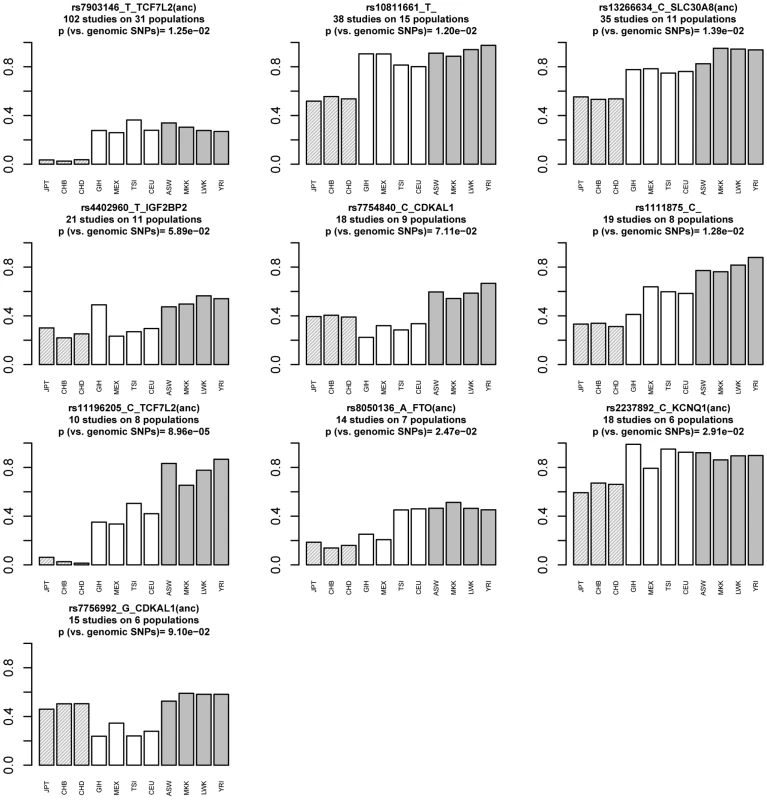
Decreasing RAF from Sub-Saharan Africa to East Asia regions at cross-ethnic T2D SNPs in HGDP individuals
We then calculated T2D RAF in 53 indigenous populations from 1,064 individuals in the Human Genome Diversity Panel (HGDP) [20]. One risk allele, rs5219 in KCNJ11 was not analyzed due to the lack of frequency data. Nine out of the remaining 11 T2D SNPs exhibited larger differentiation of RAF than 95% European frequency-matched control genomic alleles, except for two SNPs in CDKAL1 (Six SNPs in Figure 2, five SNPs in Figure S2). There is a clear pattern of gradually decreasing RAF from the Sub-Saharan Africa to the East Asia through the Europe regions, which was shared among all T2D SNPs.
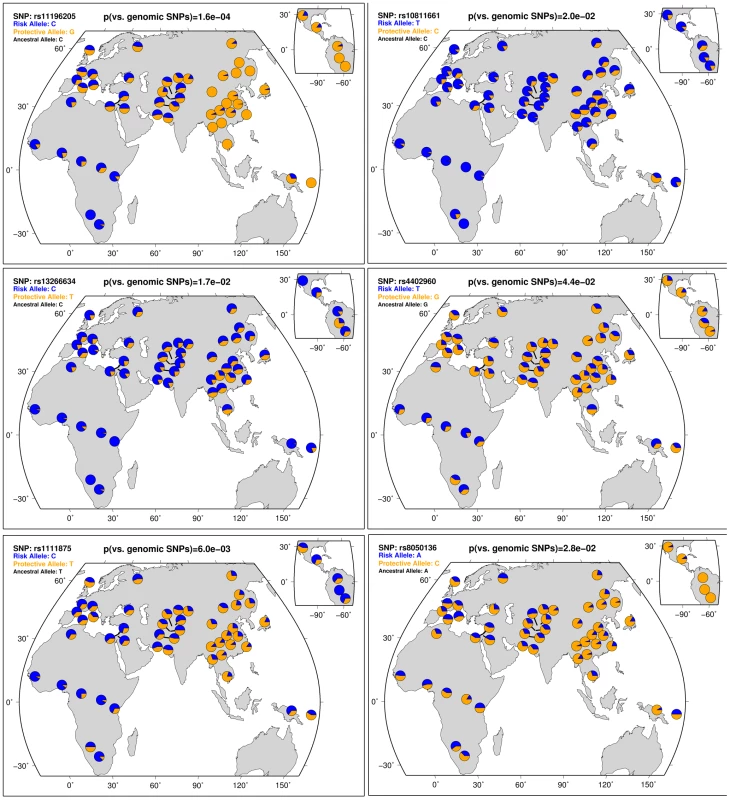
Higher FST values at T2D SNPs than frequency matched control genomic SNPs
To evaluate whether the observed allele frequency differences among continental groups for T2D SNPs are unusually high, we calculated FST as a measure of population differentiation [21]. Specifically, for each of ten cross-ethnic SNPs (rs5219 and rs2074196 were not analyzed due to the lack of frequency data), we calculated a global as well as three pairwise FST values by pooling populations for each of the three major geographic regions: Africa, Europe, and East Asia. We then compared them to the genome-wide distribution for allele frequency matched SNPs (defined as within the same 5% minor allele frequency bin in the pooled European samples). Consistent with previous results [12], [13], we found that all T2D SNPs showed elevated FST values, with five out of ten T2D SNPs among the top 10%, and one of them (rs11196205 in TCF7L2) among the top 1% of the empirical distribution for at least one of the four population comparisons (Figure S3). Overall, FST values were significantly higher in T2D SNPs than the frequency matched genomic SNPs in global FST (p = 0.0057), using a Mann-Whitney U test. Of the pairwise comparisons, FST of both African vs. East Asian (p = 0.0041) and East Asian vs. European (p = 0.025) were also highly significant, whereas African vs. European was not (p = 0.3). Thus, FST values also support our findings of extreme population differentiation at T2D SNPs.
T2D risk alleles as an ensemble showed significantly larger differentiation than other diseases using a novel directional population differentiation method
FST has been widely used to evaluate population differentiation; however, it does not take into account whether risk alleles share the same direction of population differentiation. Here, we developed a novel directional population differentiation method by comparing the average increased frequencies across all T2D risk alleles against the null distribution of European frequency-matched control genomic alleles. We randomly drew 10 genomic alleles that share similar frequencies with the T2D risk alleles in the European populations. Then we calculated their average increased frequencies in the African compared with European populations, which is defined as RAFAfrican−RAFEuropean. Repeating the process 10,000 times, we got a null distribution of increased frequencies between African and European populations. T2D risk alleles as an ensemble demonstrated significantly higher RAF in the HapMap African populations against the null distribution of control genomic alleles with a two-side p value of 1.4×10−2 (Figure 3B). We adopted the two-side p value to make our method applicable to any new disease without any prior knowledge on whether RAFAfrican−RAFEuropean is larger or smaller than 0. T2D risk alleles as an ensemble showed significantly higher RAF in the populations in the Sub-Saharan Africa regions (p = 4.9×10−2, Figure 3D), and significantly lower RAF in the East Asia regions (p = 1.0×10−4, Figure 3C), compared to control genomic alleles. We also observed very similar results when analyzing the directional population differentiation using a single T2D SNP from each gene.
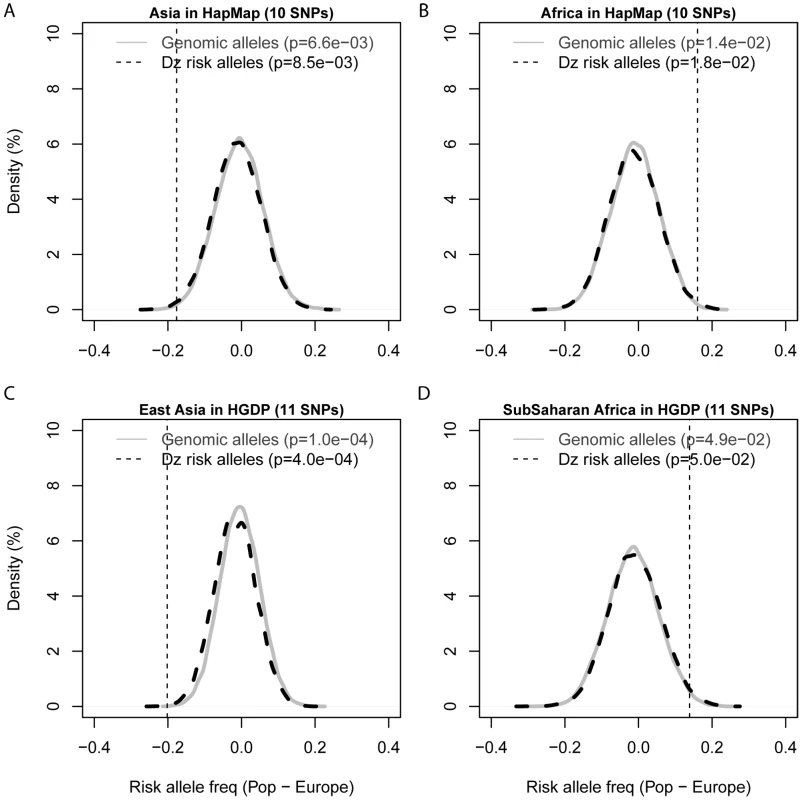
We then evaluated whether this increased RAF in the Sub-Saharan Africa regions was significant against risk alleles from hundreds of other diseases. As a background, we extracted 15,649 risk alleles that had previously been reported as significantly associated with 975 human diseases from Varimed [6]. We randomly drew 11 risk alleles which share similar frequencies with T2D risk alleles in the European populations and calculated a null distribution of increased frequencies. We found that T2D risk alleles showed significantly higher RAF in the Sub-Saharan Africa region than risk alleles from other diseases (Figure 3D, p = 0.05). Similarly, we found that T2D risk alleles showed significantly lower RAF in the HapMap Asia (p = 8.5×10−3, Figure 3A) and HGDP East Asia regions (p = 4.0×10−4, Figure 3C). Therefore, our novel method demonstrated that T2D risk alleles as an ensemble showed significantly larger population differentiation than frequency-matched control genomic alleles and risk alleles from hundreds of other diseases.
We used this method to systematically evaluate the directional differentiation of RAF of cross-ethnic risk alleles for all diseases in Varimed. We identified 12 common diseases that contain five or more independent cross-ethnic risk alleles (CEU R2<0.7); each of which had been known to associate with the disease with p<1×10−6 and be replicated in five or more different populations (Materials and Methods). T2D was the only disease that showed significantly decreased RAF in the East Asian populations (p = 1×10−4, Figure 4) and significantly increased RAF in the Sub-Saharan African populations (p = 4.9×10−2, Figure 5), compared with frequencies in the European populations. Prostate cancer showed relatively increased RAF in the Sub-Saharan African populations (p = 6.4×10−2, Figure 5), without decreased RAF in the East Asian populations ((p = 0.61, Figure 4). We repeated the study using disease-susceptible risk alleles that had been replicated in two independent papers with p<5×10−8, and got very similar results (Figures S4, S5, S6). One small difference is that prostate cancer showed significantly higher RAF in the Sub-Saharan African populations at replicated risk alleles (p = 4×10−3, Figure S6). Therefore, T2D risk alleles showed the most extreme differentiation of RAF across human populations, compared with other diseases.
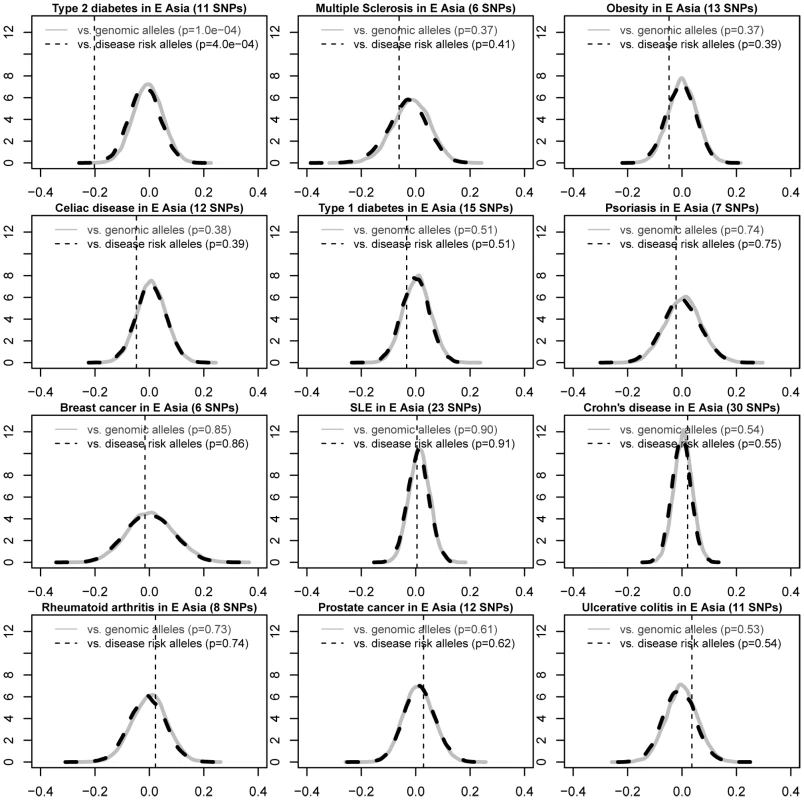
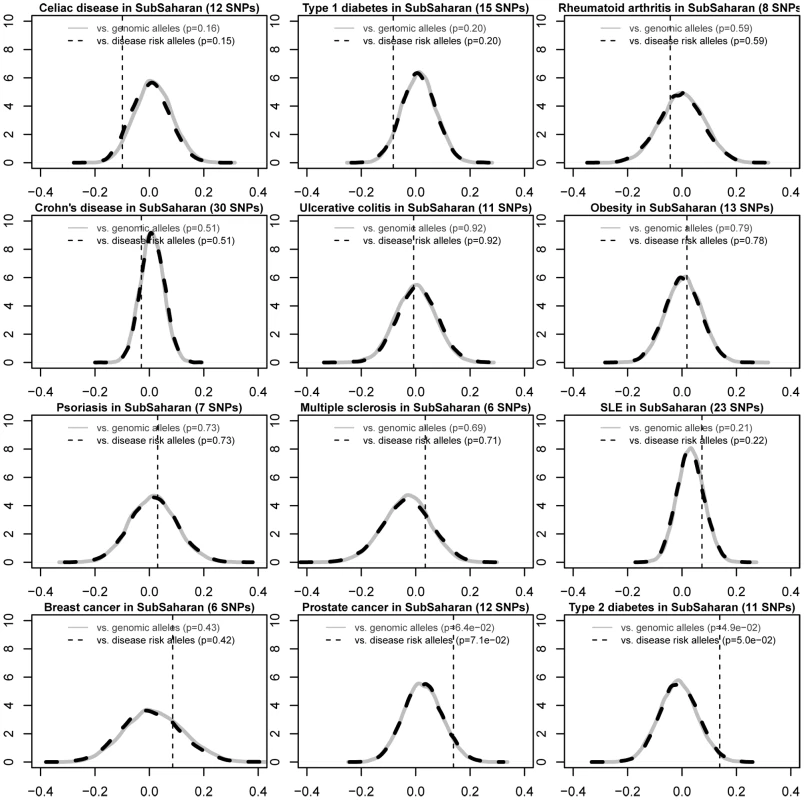
Interestingly, ensembles of obesity-susceptible risk alleles did not show significant differentiation of RAF in either East Asian (p = 0.37, Figure 4) or Sub-Saharan African populations (p = 0.79, Figure 5). Eight out of 12 independent cross-ethnic obesity-susceptible risk alleles did not show significantly larger differentiation of RAF than control genomic alleles, individually (Figure S7). Among the remaining four risk alleles, two are located within FTO and known to increase the risk of T2D as well. Therefore, we did not observe any consistent pattern of RAF across obesity-susceptible risk alleles. The decoupling between obesity- and T2D-susceptible risk alleles indicates that their evolutionary histories are likely different.
T2D showed the most significant population differentiation on Predicted Genetic Risk (PGR) among 40 diseases
Having shown the extreme differentiation of frequencies across T2D risk alleles, we further combined the effect size from all independent risk variants to systematically evaluate the differentiation of genetic risk of T2D and 39 other diseases. Using a method we had previously developed [22], [23], we calculated a Predicted Genetic Risk (PGR) of 40 diseases for each of 1,397 individuals using 1.46 million SNPs genotyped in the HapMap release 3 (HapMap3). We only used the HapMap3 data to calculate the PGR so that the same set of SNPs was used for each individual. For each disease, we identified risk SNPs that have been validated in five or more populations, estimated their increased Likelihood Ratio (LR) using the genotype frequencies in the case/control groups reported in each previous study, and finally combined the LRs from multiple SNPs using ethnic-specific linkage disequilibrium R2 data to report a summarized risk score for each disease. The summarized score estimates the Predicted Genetic Risk (PGR) for an individual given their genotypes at independent risk SNPs.
We calculated the PGR for each of 1,397 individuals on 40 diseases (Table S5), and found that seven diseases showed significantly larger population differentiation than global frequency-matched genomic SNPs (Figure 6). After Benjamini-Hochberg multi-test correction, only T2D and colorectal cancer demonstrated significantly larger population differentiation than random genomic SNPs. After accounting for the genomic SNPs, T2D showed significantly increased PGR in the African populations relative to others (p = 4.7×10−3), and significantly decreased PGR in the Asian populations relative to others (p = 3.0×10−5). Colorectal cancer showed a similar pattern, but the PGR differences among population groups were much smaller because there were only two cross-ethnic SNPs. The statistical significance of observed PGR differences was estimated using a genomic background by randomly selecting global frequency-matched genomic SNPs and re-calculating the PGR on each disease using the random SNPs. We then calculated the likelihood of observing a larger PGR difference between each of three population groups (Asian, European, African) and others. Overall, T2D demonstrated the most significant population differentiation on PGR compared to frequency-matched genomic SNPs.
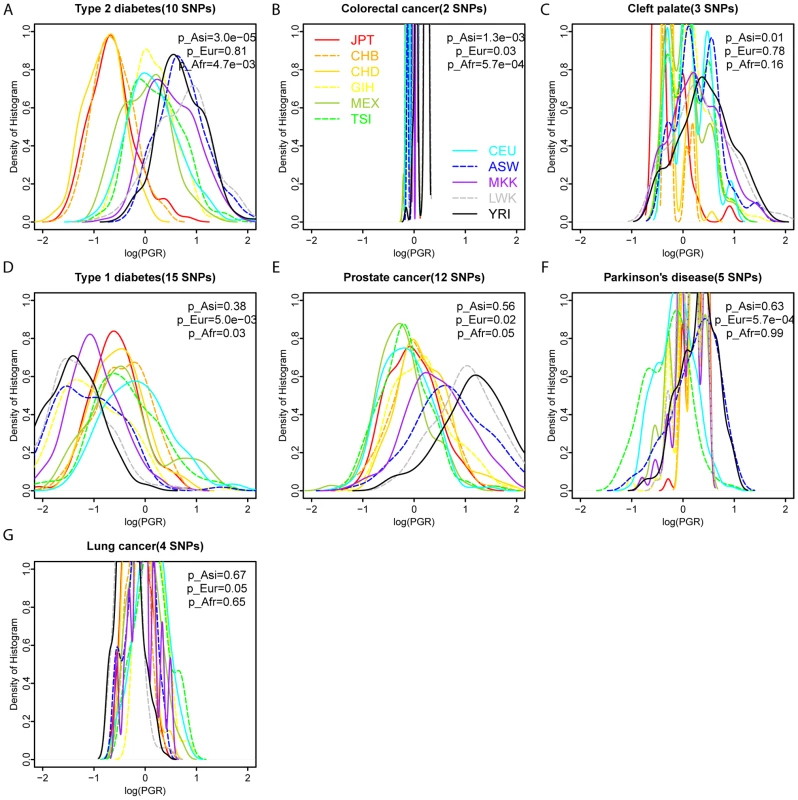
Consistent pattern of T2D PGR using ethnic-specific SNPs, validated risk scores, and different genotyping/sequencing technologies
Finally, we evaluated the robustness of the observed ethnic disparity of T2D PGR in three conditions. To evaluate the effect of SNPs discovered and validated in specific subpopulations, we compared the distributions of PGR using only the ethnicity-specific T2D SNPs, their genotype frequencies in the case and control groups, and LR separately from studies specifically on each of the following ethnicities: Caucasian, African, Chinese, Japanese, and Indian Asian (Figure 7). T2D PGR distributions demonstrated a strikingly similar pattern no matter which original studies were used to retrieve the previously discovered significant T2D SNPs, genotype frequencies, and LRs. African populations always have the highest PGR and Asian populations always have the lowest PGR.
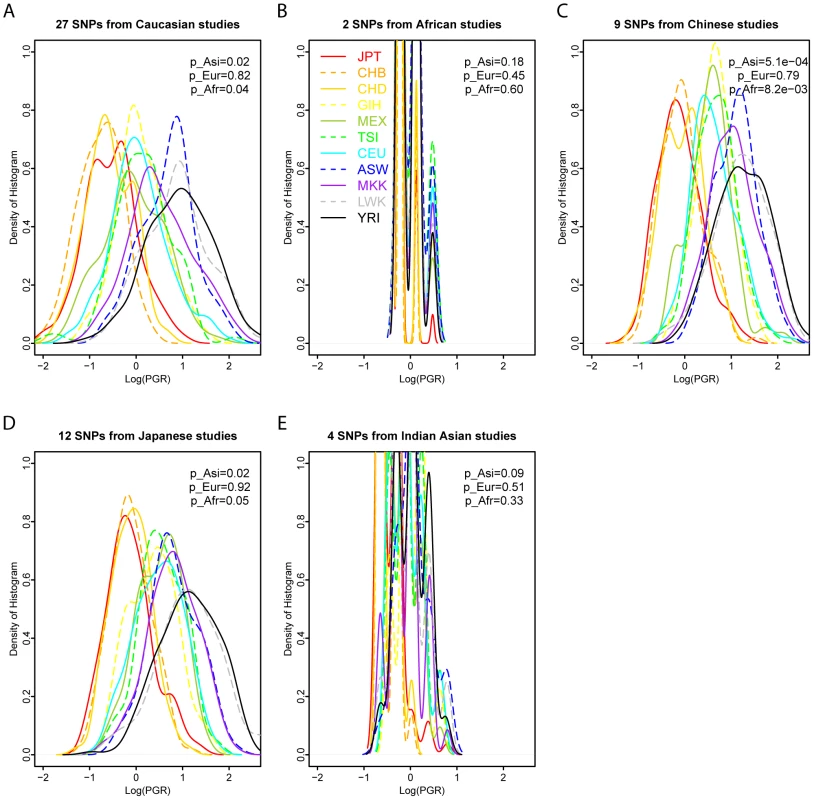
Recently, a T2D genetic risk score had been validated to associate with the increased risk of developing diabetes in a prospective random trial on 2,843 Diabetes Prevention Program participants from five ethnic groups representative of the U.S. population [19]. The T2D genetic risk score was calculated by multiplying the number of risk alleles by the natural log of the odds ratio at each SNP, and summing over 34 SNPs. Twenty SNPs were measured in the HapMap3 individuals. We calculated the T2D risk score for each of 1,397 HapMap3 individuals, and found the same differential T2D genetic risks, with significantly increased risk in the African populations (p = 0.01) and significantly decreased risk in the Asian populations (p = 3.5×10−3, Figure 8).
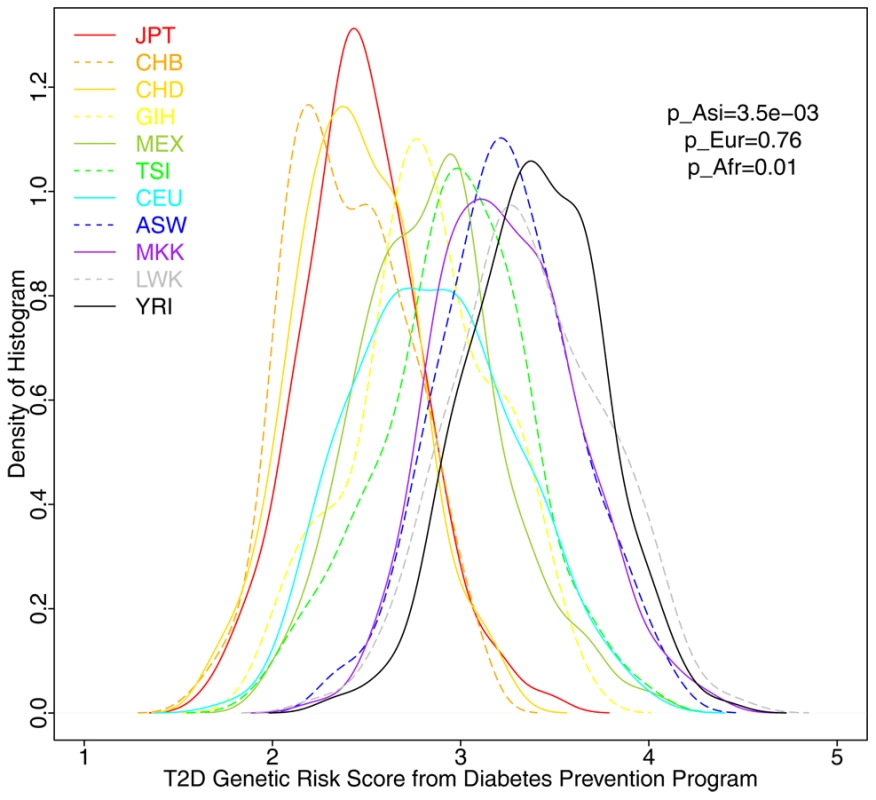
Third, in each of the studies above, we were constrained in the number of SNPs usable for calculating PGR for T2D, based on intersecting the set of SNPs known to be associated with T2D with the set of SNPs genotyped in individuals in HapMap3 and HGDP. To ensure our findings are not an artifact of bias in the measured SNPs, we repeated our analysis using a larger set of T2D associated SNPs in 49 individuals for which whole genome sequencing is obtained, including 4 JPT, 4 CHB, 5 MEX, 3 Puerto Rican, 2 TSI, 14 CEU, 5 ASW, 1 MKK, 4 LWK, and 7 YRI. The subpopulation distributions of PGR were very similar between whole genome sequencing and genotyping technologies (HapMap3) for T2D (Figure 9). This equality did not hold for all diseases, as very different distributions are observed for melanoma. This suggests that current genotyping technology captures enough signals to reproduce the ethnic disparity for some common diseases, such as T2D, while whole genome sequencing will likely capture many more genetic variants influencing melanoma and perhaps other diseases.
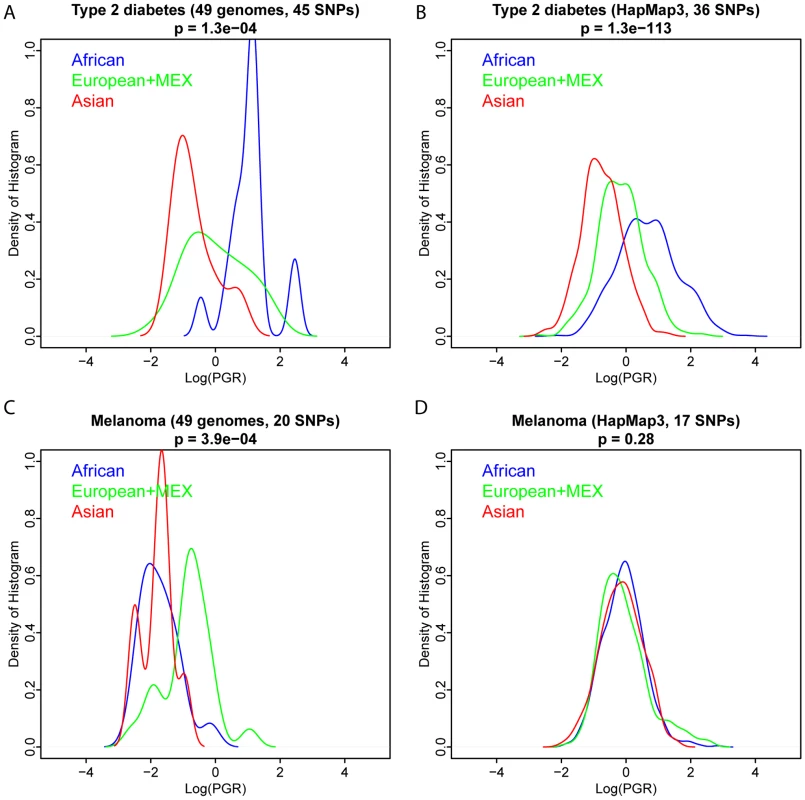
Discussion
We developed a novel method to systematically evaluate the directional differentiation of Risk Allele Frequencies (RAF) of ensembles of cross-ethnic SNPs for 12 common diseases across 11 populations from the HapMap project and 53 indigenous populations from the HGDP project. We found that type 2 diabetes (T2D) demonstrated the significant differentiation of RAF among diverse populations, compared with the European frequency-matched control genomic alleles and risk alleles for other diseases (Figure 3, Figure S4). T2D showed the most extreme differentiation among 12 common diseases, no matter whether we used cross-ethnic SNPs that had been replicated in five different populations (Figure 4, Figure 5) or SNPs that had been replicated in two studies (Figures S5, S6). This extreme differentiation is caused by the phenomenon that all T2D risk alleles share a consistent pattern of gradually decreasing population frequencies from Sub-Saharan Africa through Europe to East Asia regions (Figure 1, Figure 2, Figure S2).
This phenomenon, that T2D risk alleles decrease frequencies when humans migrate [24], suggests many potential explanations. One likely cause is the adaptation to the disparities of agriculture development across continents. It has been previously reported that some T2D SNPs have higher risk allele frequencies in populations where cereals are the main dietary component, and observed risk allele frequency might be related to historical events, such as the dispersal out of Sub-Saharan Africa to regions with different climates and the adoption of more specialized-often less diverse-diets (i.e. farming and animal husbandry vs. foraging) [25]. There were three major events in human evolution, including early migration from 200KYA to 10KYA, agriculture revolution and population expansion from 10KYA to 4KYA, and new world discovery and associated mass-migration and admixture after 4KYA [26]. The significantly decreased frequencies of T2D risk alleles in the East Asia might be caused by the agriculture revolution, including the cultivation of white rice and pork in China. A related explanation stems from the thrifty genotype [27] hypothesis, which asserts that a predisposition to insulin resistance may have protected individuals during periods of food deprivation by reducing muscle utilization of glucose and favoring glucose utilization in organs, such as brain, that operates through an insulin independent mechanism [27]. Combining these two related explanations together, we speculate that the decreasing T2D risk allele frequencies are caused by the promotion of energy storage and usage appropriate to environments and insistent energy intakes.
Another speculation is that T2D is known to find roots in the mismatch between our genetics and environment, as food contributes a significant environmental impact. When humans migrate, environmental change may have led to a mismatch between genetics and available diet, and put a positive evolutionary pressure on the frequencies of T2D protective alleles. Therefore, the decreasing T2D risk alleles are expected, while the other diseases are unusual given the underlying demographic history. Future evolutionary analysis on these T2D SNPs may provide some insight on the origin of this pandemic disease, as will more population-specific genetic studies.
Having shown the extreme differentiation of T2D RAF, we further combined the effect sizes from all independent risk variants and calculated a Predicted Genetic Risk (PGR) for each of 1,397 individuals in the HapMap3 project. T2D showed the most significant population differentiation among 40 diseases, after correcting for control genomic genotypes (Figure 6). We identified a consistent pattern of high PGR in the African and low PGR in the Asian regardless whether we used ethnic-specific SNPs (Figure 7), validated risk scores (Figure 8), or different genotyping/sequencing technologies (Figure 9). Our results indicate that there is indeed a differential T2D genetic risk across different populations across continents. The distributions we have found are very similar to a recent report measuring 19 common variants on five continent populations [15], with the highest risk in the African populations, and lowest risk in the East Asian populations.
The populations examined by this study are distributed broadly around the world, representing a wide range of environmental exposures and lifestyles. Hence, it is challenging to associate the increased prevalence of risk-associated alleles with actual manifestations of T2D, which we know to be heavily influenced by environmental factors. However, studies in England and the United States have consistently shown that individuals with African ancestry have increased diabetes rates relative to their neighbors of European or East Asian ancestry [28]–[31], while those with Chinese ancestry had lower incidence compared to others in a recent 10-year Canadian study [32]. At the same time, citizens in China have higher prevalence of T2D within their own country [33], [34]. Disparities in T2D rates may be attributed to social, cultural, and economic differences or possible genetic confounders such as admixing of ancestral ethnicities, though our results suggest that differential genetics may indeed play some role in these differences in incidence rates.
We also found that African had higher PGR on prostate cancer than other populations. Epidemiology data from Center for Disease Control and Prevention from 1999 to 2007 show that incidence of prostate cancer is 1.56 times higher in the African American than white American. Further investigation on the genetic reasons behind the observed ethnic disparity of disease incidence rates across ethnic/racial groups might identify personalized medicine to improve the health disparity.
Many challenges to evaluate the population differentiation of RAF and PGR remain. Foremost, many of the SNPs identified from genome-wide association studies (GWASs) are tag SNPs and are therefore not assumed to be causal [35]. However, each of the 12 cross-ethnic T2D SNP share the same risk allele and similar effect sizes across 34 different studied populations (Figure S1, Table S2), suggesting that they are the best representatives of the causal alleles based on the current data. The consistent observation of differential T2D genetic risk with different SNPs, risk scores, and technologies suggests validity as new causal variants are identified, but this remains a hypothesis that needs to be tested in the future. Second, we acknowledge that we adopted a relaxed p value cutoff of p<1×10−6 to identify cross-ethnic SNPs for a wide-variety of diseases for comparisons. With more GWAS in diverse population groups, a more rigorous cutoff and ethnicity-specific effects should be used. Third, there may be some ethnic-specific gene-environment interaction. Forth, our observed disparity of PGR between population groups might be related to the disparities in the application of modern genetic tools to study diseases across ethnicities. Finally, a large component of heritable risk is still missing for most common diseases, and consequently missing in our analysis here [36]. Future GWAS and sequencing studies on different ethnic groups under diversified environmental conditions will likely further reveal and illustrate the origins of complex diseases.
In conclusion, we found that T2D risk alleles demonstrated extreme differentiation compared to other diseases, with population frequencies decreasing from Sub-Saharan Africa and through Europe to East Asia. These patterns may contribute to the observed disparity of T2D incidence rates across worldwide ethnic populations.
Materials and Methods
VARiant Informing MEDicine (Varimed): A quantitative disease–SNP association database
As described previously [6], we have been manually curating a quantitative human disease-SNP association database from literature. First, we downloaded all abstracts from MEDLINE, and identified human genetic papers using a list of Medical Subject Headings [37], such as “Genome-Wide Association Study”, “Genetic Variation”, “Polymorphism, Genetic”, “Genome, Human”, “Polymorphism, Single Nucleotide”, “Genotype”, “Genetic Predisposition to Disease”, “Case-Control Studies”, “Alleles”, “Cohort Studies”. We then filtered these papers through abstracts, titles, and keywords. We also downloaded papers from curated disease-SNP databases, such as GWAS catalog from National Human Genome Research Institute [38]. Combined together, we identified 5,065 human genetic papers representing 1,495 diseases. Second, four curators manually extracted data from the full text, figures, tables, and supplemental materials of 5,065 human genetics papers, and recorded more than 100 features from each paper. We recorded many aspects of the associations, including the disease name (e.g. coronary artery disease), specific phenotype (e.g. acute coronary syndrome in coronary artery disease), study population (e.g. Finnish individuals), case and control population (e.g. 2,508 patients with coronary artery disease proven by angiography), gender distribution, genotyping technology, major/minor/risk alleles, odds ratio, 95% confidence interval of the odds ratio, published p value, and genetic model. Studies on similar diseases were categorized and mapped to the Concept Unique Identifiers (CUI) from the Unified Medical Language System (UMLS) [39]. For each study, the frequencies of each genotype and allele in the case and control populations were recorded, and used to estimate the effect size [22], [23].
Systematically identify independent cross-ethnic and replicated risk alleles for 12 diseases
We identified all disease-susceptible alleles from Varimed that were reported to increase the risk of human disease with p-value<10−6. We focused on alleles that were directly associated with the increased risk of human disease by removing the following SNPs: SNPs that were specified as non-significant in the original papers, SNPs that were identified from studies with diseased patients in the control groups, SNPs that were associated with non-disease traits, SNPs that were associated with disease through haplotype blocks or interaction terms. Risk alleles on the negative strands were translated into alleles in the positive strands. Negative strands were identified by comparing the major/minor alleles in the study with the major/minor alleles in the similar population in the HapMap3. Many risk alleles had been reported in multiple studies, and we integrated all studies and ranked the risk alleles by the strength of replication, including the number of replicated populations, studies, and total sample sizes.
We identified cross-ethnic SNPs as SNPs being associated with a disease with a p-value<1×10−6 in at least one populations and reported as significant in five or more different subpopulations with a p-value<1×10−6 in GWAS studies or p-value<0.01 in small candidate studies. We removed SNPs that were specified as non-significant in the original papers. For each disease, we ranked all cross-ethnic SNPs by the number of replication studies, the total sample sizes and the number of populations where the associations being replicated. Starting from risk alleles with the strongest evidence, we identified risk alleles with the linkage disequilibrium R2≥0.7 in the CEU population in the HapMap project, and removed ones with less evidence. We identified 12 diseases with 5 or more independent cross-ethnic risk alleles, each of them being validated in five or more populations. We found 12 independent cross-ethnic risk alleles for Type 2 diabetes (T2D), and plotted their association p values across 34 populations using the levelplot function in R. We then evaluated the between-study heterogeneity of allelic odds ratios on each of 12 cross-ethnic T2D SNPs using the meta R package. Similarly, we identified disease SNPs that have been replicated in two or more papers with p<5×10−8.
Evaluate the population differentiation of RAF against European frequency-matched control genomic alleles at individual disease-susceptible SNP
We retrieved the allele frequencies at 2.3 million SNPs in the 11 populations from HapMap 2+3, which were released in August 2010. We plotted the RAFs across the 11 populations as bar graphs at each independent cross-ethnic risk allele for each disease using a barplot function in R.
We then evaluated the statistical significance of the population differentiation of RAF at each disease SNP by calculating the percentage of European frequency-matched control genomic alleles that show the RAF difference larger than the observed. For each risk allele, we retrieved all control genomic alleles sharing similar average frequencies within ±0.01 in the European (TSI, CEU) populations. Then, we calculated the percentage of matched genomic alleles that have both African frequencies higher than the observed and Asian frequencies lower than the observed. We recorded the percentage as a p value which is the likelihood of finding similar or larger differentiation of RAF from frequency-matched genomic alleles. All risk alleles with p<0.05 were considered as showing significantly larger population differentiation than control genomic alleles.
We received the measured and imputed allele frequencies at 3.1 million SNPs across 53 populations from 1,064 individuals from Human Genome Diversity Panel (HGDP) from Joseph Pickrell from University of Chicago [7], [13]. We modified a script from Joseph Pickrell using Generic Mapping Tools [40] and plotted the worldwide map showing the distribution of RAF across the 53 HGDP populations [13]. Similar with the analysis on HapMap, we calculated the percentages of European frequency-matched genome alleles that have both Sub-Saharan African frequencies higher than the observed and East Asian frequencies lower than the observed.
We categorized populations into three major regions. Sub-Saharan Africa region includes BantuSouthAfrica, Biaka Pygmies, Mandenka, Mbuti Pygmies, San, Yoruba, and BantuKenya. East Asia region includes Cambodian, Dai, Daur, Han, Han-NChina, Hezhen, Japanese, Lahu, Miao, Mongola, Naxi, Oroqen, She, Tu, Tujia, Uygur, Xibo, Yakut, and Yi. Europe region includes Adygei, Basque, French, Italian, Orcadian, Russian, Sardinian, and Tuscan.
Compare FST values of T2D SNPs against those of control genomic SNPs
Global FST, as well as three pairwise FST (African vs. East Asian, African vs. European, East Asian vs. European) values were calculated for all SNPs from HapMap3, using a custom script implementing the method in the PopGen module of BioPerl [41]. For the calculations, all populations for the respective geographic regions were pooled, so that the global FST reflected the overall differentiation of those major geographic regions. All SNPs were grouped into 10 bins according to their average Minor Allele Frequencies (MAF) across the European HapMap3 populations (CEU, TSI), and T2D SNPs were compared to all genomic SNPs within the same MAF bin. For the Mann-Whitney U test, we used normalized FST values, which were obtained by subtracting the mean and dividing by the standard deviation within each MAF bin for each SNP.
Systematically evaluate directional population differentiation of ensembles of independent cross-ethnic risk alleles for 12 diseases
We evaluated the population differentiation of an ensemble of 10 independent cross-ethnic T2D risk alleles by comparing their average increased RAF in the African populations against the null distribution of control genomic alleles and 15,649 risk alleles from 975 diseases. First, we randomly retrieved 10 control genomic alleles that share similar European frequencies (±0.05) with T2D risk alleles, and calculated their average increased frequencies in the African populations (MKK, LWK, YRI, ASW). Repeating the above process 10,000 times, we drew a null distribution of increased frequencies between African and European populations from control genomic alleles. The average increased frequency of 10 T2D risk alleles in the African vs. European populations was then compared with the null distribution to calculate the likelihood of observing consistently increased African frequencies from matched genomic alleles.
Similarly, we randomly retrieved 10 European frequency-matched alleles (±0.05) from 15,649 risk alleles from other diseases, and calculated a null distribution of increased African frequencies from disease risk alleles. We also calculated the null distribution of Asian frequencies from HapMap, East Asian and Sub-Saharan African frequencies from HGDP using European frequency-matched genomic alleles and risk alleles from other diseases.
Calculate the distribution of PGR across the 11 HapMap3 population groups
Using a method we described previously [22], [23], we calculated the Predicted Genetic Risk (PGR) of 40 diseases for 1,397 individuals from HapMap release 3. Each individual was genotyped at 1.46 million SNPs. We calculated the PGR of 40 diseases using independent cross-ethnic SNPs, each of them had been validated in five or more different populations. We estimated a genetic risk using a likelihood ratio for each SNP defined by the relative frequency of an individual's genotype in the diseased vs. healthy control populations (e.g., given a genotype “AA”, LR = Pr(AA|diseased)/Pr(AA|control)). The LR incorporated both the sensitivity and specificity of the test and provided a direct estimate of how much a test result would change the odds of having a disease [23]. We excluded studies with diseased patients in the control group. For each allele, we averaged the LRs from multiple studies with a weight of the square root of the sample size to give higher confidence to studies with larger sample size. For SNP pairs in linkage disequilibrium (R2≥0.3 in the corresponding population group), we removed the SNP with weaker evidence according to the number of replication studies, sample sizes and validated populations. We considered remaining SNPs as independent genetic test and multiplied their LRs to report the summarized score as the PGR. We then plotted the distribution of PGR across 11 HapMap populations using a kernel density function in the R package.
Evaluate the statistical significance of population differentiation of PGR against control genomic SNPs
To evaluate the statistical significance of the population differentiation of PGR after correcting the difference of RAF, we randomly replaced disease genotypes with global frequency-matched non-associated genotypes, and re-calculated the PGR for each of 1,397 HapMap individuals. We calculated the PGR using the random control genomic genotypes along with the original LR, averaged the log(PGR) values for each of 11 population groups, and repeated the process 100,000 times. Then we calculated the p_Afr as the percentage of obtaining a value of log(PGR, African)-log(PGR, Other) from random genotypes larger than the observed values. Similarly, we calculated p_Asi and P_Eur as the likelihood of obtaining more extreme values of log(PGR, Asian)-log(PGR, Other) and log(PGR, European)-log(PGR, Other) from random genomic genotypes. Each p value was calculated as a two-side p value.
Calculate the distribution of PGR using SNPs and LRs from ethnic-specific studies
We recalculated the distribution of PGR across the 11 HapMap populations using SNPs and LRs that were associated with T2D with p<1×10−6 in the original studies on each of the following populations, including Caucasian, African, Chinese, Japanese, and Indian Asian.
Whole-genome sequences of 49 individuals from 10 population groups
Whole-genome sequences were produced using published methods [42] for 49 cell-line derived DNA samples obtained from the Coriell Institute. Each genome was sequenced to over 55× coverage and calls were produced using a local de novo assembly based pipeline. Comparison of these data to dbSNP was performed using alignment-based methods which account for SNPs which may be contained within more complex variant sequences.
We pooled the 49 samples into three groups: Asian, African, and Others. Then we calculated the distribution of PGR across these three population groups on T2D and Melanoma. All disease SNPs with p<1×10−6 in the original studies on any ethnicity were used.
Supporting Information
Zdroje
1. van DierenSBeulensJWvan der SchouwYTGrobbeeDENealB 2010 The global burden of diabetes and its complications: an emerging pandemic. Eur J Cardiovasc Prev Rehabil 17 Suppl 1 S3 8
2. GroopLLyssenkoV 2008 Genes and type 2 diabetes mellitus. Curr Diab Rep 8 192 197
3. LyssenkoVJonssonAAlmgrenPPulizziNIsomaaB 2008 Clinical risk factors, DNA variants, and the development of type 2 diabetes. N Engl J Med 359 2220 2232
4. AltshulerDMGibbsRAPeltonenLDermitzakisESchaffnerSF 2010 Integrating common and rare genetic variation in diverse human populations. Nature 467 52 58
5. CannHMde TomaCCazesLLegrandMFMorelV 2002 A human genome diversity cell line panel. Science 296 261 262
6. ChenRDavydovEVSirotaMButteAJ 2010 Non-Synonymous and Synonymous Coding SNPs Show Similar Likelihood and Effect Size of Human Disease Association. PLoS ONE 5 e13574 doi:10.1371/journal.pone.0013574
7. LiJZAbsherDMTangHSouthwickAMCastoAM 2008 Worldwide human relationships inferred from genome-wide patterns of variation. Science 319 1100 1104
8. KhouryMJBertramLBoffettaPButterworthASChanockSJ 2009 Genome-wide association studies, field synopses, and the development of the knowledge base on genetic variation and human diseases. Am J Epidemiol 170 269 279
9. AdeyemoARotimiC 2010 Genetic variants associated with complex human diseases show wide variation across multiple populations. Public Health Genomics 13 72 79
10. RotimiCNJordeLB 2010 Ancestry and disease in the age of genomic medicine. N Engl J Med 363 1551 1558
11. DicksonSPWangKKrantzIHakonarsonHGoldsteinDB 2010 Rare variants create synthetic genome-wide associations. PLoS Biol 8 e1000294 doi:10.1371/journal.pbio.1000294
12. KlimentidisYCAbramsMWangJFernandezJRAllisonDB 2010 Natural selection at genomic regions associated with obesity and type-2 diabetes: East Asians and sub-Saharan Africans exhibit high levels of differentiation at type-2 diabetes regions. Hum Genet
13. PickrellJKCoopGNovembreJKudaravalliSLiJZ 2009 Signals of recent positive selection in a worldwide sample of human populations. Genome Res 19 826 837
14. SouthamLSoranzoNMontgomerySBFraylingTMMcCarthyMI 2009 Is the thrifty genotype hypothesis supported by evidence based on confirmed type 2 diabetes- and obesity-susceptibility variants? Diabetologia 52 1846 1851
15. WatersKMStramDOHassaneinMTLe MarchandLWilkensLR 2010 Consistent association of type 2 diabetes risk variants found in europeans in diverse racial and ethnic groups. PLoS Genet 6 e1001078 doi:10.1371/journal.pgen.1001078
16. CauchiSEl AchhabYChoquetHDinaCKremplerF 2007 TCF7L2 is reproducibly associated with type 2 diabetes in various ethnic groups: a global meta-analysis. J Mol Med 85 777 782
17. ElbeinSC 2009 Genetics factors contributing to type 2 diabetes across ethnicities. J Diabetes Sci Technol 3 685 689
18. FraylingTM 2007 Genome-wide association studies provide new insights into type 2 diabetes aetiology. Nat Rev Genet 8 657 662
19. HivertMFJablonskiKAPerreaultLSaxenaRMcAteerJB 2011 Updated genetic score based on 34 confirmed type 2 diabetes Loci is associated with diabetes incidence and regression to normoglycemia in the diabetes prevention program. Diabetes 60 1340 1348
20. CannHM 1998 Human genome diversity. C R Acad Sci III 321 443 446
21. LewontinRCKrakauerJ 1973 Distribution of gene frequency as a test of the theory of the selective neutrality of polymorphisms. Genetics 74 175 195
22. AshleyEAButteAJWheelerMTChenRKleinTE 2010 Clinical assessment incorporating a personal genome. Lancet 375 1525 1535
23. MorganAAChenRButteAJ 2010 Likelihood ratios for genome medicine. Genome Med 2 30
24. GibbonsA 2011 12th International Congress of Human Genetics. Diabetes genes decline out of Africa. Science 334 583
25. HancockAMWitonskyDBEhlerEAlkorta-AranburuGBeallC 2010 Colloquium paper: human adaptations to diet, subsistence, and ecoregion are due to subtle shifts in allele frequency. Proc Natl Acad Sci U S A 107 Suppl 2 8924 8930
26. BalaresquePLBallereauSJJoblingMA 2007 Challenges in human genetic diversity: demographic history and adaptation. Hum Mol Genet 16 Spec No. 2 R134 139
27. NeelJV 1962 Diabetes mellitus: a “thrifty” genotype rendered detrimental by “progress”? Am J Hum Genet 14 353 362
28. CDC 2007 2007 National Diabetes Fact Sheet
29. CongdonP 2006 Estimating diabetes prevalence by small area in England. J Public Health (Oxf) 28 71 81
30. MatySCJamesSAKaplanGA 2010 Life-course socioeconomic position and incidence of diabetes mellitus among blacks and whites: the Alameda County Study, 1965–1999. Am J Public Health 100 137 145
31. RisteLKhanFCruickshankK 2001 High prevalence of type 2 diabetes in all ethnic groups, including Europeans, in a British inner city: relative poverty, history, inactivity, or 21st century Europe? Diabetes Care 24 1377 1383
32. KhanNAWangHAnandSJinYCampbellNR 2010 Ethnicity and Sex Impact Diabetes Incidence and Outcomes. Diabetes Care
33. ZhaoDZhaoFLiYZhengZ 2011 Projected and Observed Diabetes Epidemics in China and Beyond. Curr Cardiol Rep
34. MuYMMisraAAdamJMChanSPChowFC 2011 Managing diabetes in Asia: Overcoming obstacles and the role of DPP-IV inhibitors. Diabetes Res Clin Pract
35. CirulliETGoldsteinDB 2010 Uncovering the roles of rare variants in common disease through whole-genome sequencing. Nat Rev Genet 11 415 425
36. ManolioTACollinsFSCoxNJGoldsteinDBHindorffLA 2009 Finding the missing heritability of complex diseases. Nature 461 747 753
37. RogersFB 1963 Medical subject headings. Bull Med Libr Assoc 51 114 116
38. HindorffLASethupathyPJunkinsHARamosEMMehtaJP 2009 Potential etiologic and functional implications of genome-wide association loci for human diseases and traits. Proc Natl Acad Sci U S A 106 9362 9367
39. BodenreiderO 2004 The Unified Medical Language System (UMLS): integrating biomedical terminology. Nucleic Acids Res 32 D267 270
40. Wessel PaWHFS 1991 Free software helps map and display data. EOS Trans 72
41. StajichJEHahnMW 2005 Disentangling the effects of demography and selection in human history. Mol Biol Evol 22 63 73
42. DrmanacRSparksABCallowMJHalpernALBurnsNL 2010 Human genome sequencing using unchained base reads on self-assembling DNA nanoarrays. Science 327 78 81
Štítky
Genetika Reprodukčná medicínaČlánok vyšiel v časopise
PLOS Genetics
2012 Číslo 4
- Je „freeze-all“ pro všechny? Odborníci na fertilitu diskutovali na virtuálním summitu
- Gynekologové a odborníci na reprodukční medicínu se sejdou na prvním virtuálním summitu
Najčítanejšie v tomto čísle
- A Coordinated Interdependent Protein Circuitry Stabilizes the Kinetochore Ensemble to Protect CENP-A in the Human Pathogenic Yeast
- Coordinate Regulation of Lipid Metabolism by Novel Nuclear Receptor Partnerships
- Defective Membrane Remodeling in Neuromuscular Diseases: Insights from Animal Models
- Formation of Rigid, Non-Flight Forewings (Elytra) of a Beetle Requires Two Major Cuticular Proteins
